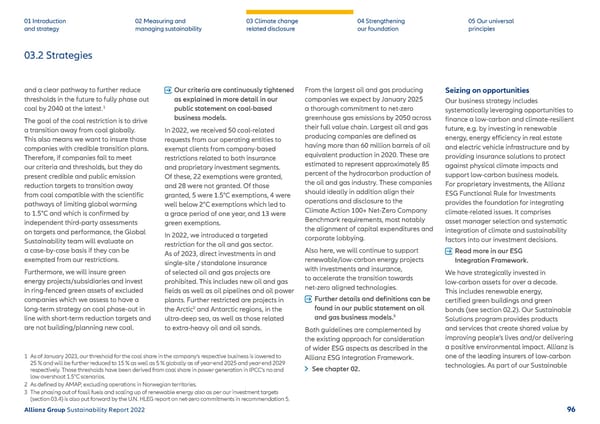03.2 Strategies and a clear pathway to further reduce thresholds in the future to fully phase out coal by 2040 at the latest. 1 01 Introduction and strategy 02 Measuring and managing sustainability 03 Climate change related disclosure 04 Strengthening our foundation 05 Our universal principles The goal of the coal restriction is to drive a transition away from coal globally. This also means we want to insure those companies with credible transition plans. Therefore, if companies fail to meet our criteria and thresholds, but they do present credible and public emission reduction targets to transition away from coal compatible with the scientific pathways of limiting global warming to 1.5°C and which is confirmed by independent third-party assessments on targets and performance, the Global Sustainability team will evaluate on a case-by-case basis if they can be exempted from our restrictions. Furthermore, we will insure green energy projects/subsidiaries and invest in ring-fenced green assets of excluded companies which we assess to have a long-term strategy on coal phase-out in line with short-term reduction targets and are not building/planning new coal. Our criteria are continuously tightened as explained in more detail in our public statement on coal-based business models. In 2022, we received 50 coal-related requests from our operating entities to exempt clients from company-based restrictions related to both insurance and proprietary investment segments. Of these, 22 exemptions were granted, and 28 were not granted. Of those granted, 5 were 1.5°C exemptions, 4 were well below 2°C exemptions which led to a grace period of one year, and 13 were green exemptions. In 2022, we introduced a targeted r estriction for the oil and gas sector. As of 2023, direct investments in and single-site / standalone insurance of selected oil and gas projects are prohibited. This includes new oil and gas fields as well as oil pipelines and oil power plants. Further restricted are projects in the Arctic 2 and Antarctic regions, in the ultra-deep sea, as well as those related to extra-heavy oil and oil sands. From the largest oil and gas producing c ompanies we expect by January 2025 a thorough commitment to net-zero greenhouse gas emissions by 2050 across their full value chain. Largest oil and gas producing companies are defined as having more than 60 million barrels of oil equivalent production in 2020. These are estimated to represent approximately 85 percent of the hydrocarbon production of the oil and gas industry. These companies should ideally in addition align their operations and disclosure to the Climate Action 100+ Net-Zero Company Benchmark requirements, most notably the alignment of capital expenditures and corporate lobbying. Also here, we will continue to support r enewable/low-carbon energy projects with investments and insurance, to accelerate the transition towards net-zero aligned technologies. Further details and definitions can be found in our public statement on oil and gas business models. 3 Both guidelines are complemented by the e xisting approach for consideration of wider ESG aspects as described in the Allianz ESG Integration Framework. See chapter 02. Seizing on opportunities Our business strategy includes systematically leveraging opportunities to finance a low-carbon and climate-resilient future, e.g. by investing in renewable energy, energy efficiency in real estate and electric vehicle infrastructure and by providing insurance solutions to protect against physical climate impacts and support low-carbon business models. For proprietary investments, the Allianz ESG Functional Rule for Investments provides the foundation for integrating climate-related issues. It comprises asset manager selection and systematic integration of climate and sustainability factors into our investment decisions. Read more in our ESG Integration Framework. 1 As of January 2023, our threshold for the coal share in the company’s respective business is lowered to 25 % and will be further reduced to 15 % as well as 5 % globally as of year-end 2025 and year-end 2029 respectively. Those thresholds have been derived from coal share in power generation in IPCC’s no and low overshoot 1.5°C scenarios. 2 As defined by AMAP, excluding operations in Norwegian territories. 3 The phasing out of fossil fuels and scaling up of renewable energy also as per our investment targets ( section 03.4 ) is also put forward by the U.N. HLEG report on net-zero commitments in recommendation 5. We have strategically invested in low-carbon assets for over a decade. This includes renewable energy, certified green buildings and green bonds ( see section 02.2 ). Our Sustainable Solutions pr ogram provides products and services that create shared value by improving people’s lives and/or delivering a positive environmental impact. Allianz is one of the leading insurers of low-carbon technologies. As part of our Sustainable Allianz Group Sustainability Report 2022 96
 Sustainability Report 2022 | Allianz Page 96 Page 98
Sustainability Report 2022 | Allianz Page 96 Page 98